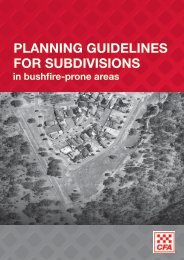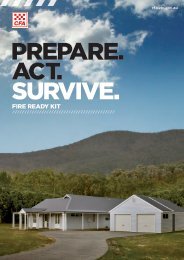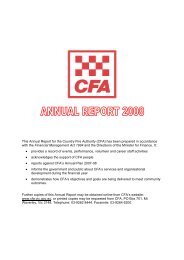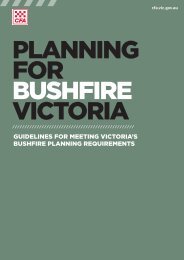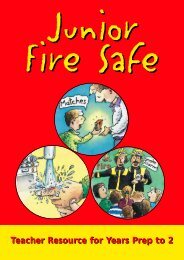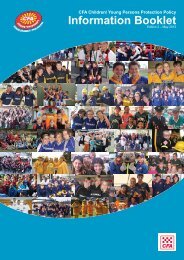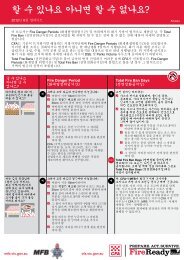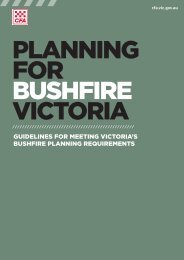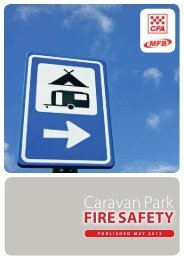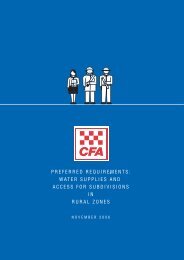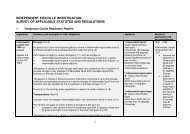Download part 2 - Country Fire Authority
Download part 2 - Country Fire Authority
Download part 2 - Country Fire Authority
Create successful ePaper yourself
Turn your PDF publications into a flip-book with our unique Google optimized e-Paper software.
How do firefighters fight bushfires?<br />
The Officer in Charge of the Brigade responsible for controlling the bushfire in the area<br />
makes a plan to fight the fire. He/She directs fire trucks, decides how the fire will be fought,<br />
has contact with surveillance aircraft, and access to weather information. Helicopters and<br />
aircraft may be used to observe the fire and give information to the Officer in Charge.<br />
<strong>Fire</strong> tankers and fire aircraft are used to carry supplies of water gathered from water holes or<br />
dams, or another adequate water supply, to the scene of the bushfire. <strong>Fire</strong> hoses attached<br />
to the tankers allow the firefighters to easily carry water into the fire. <strong>Fire</strong>fighters are divided<br />
into teams, fighting the fire from different sides, to enable them to close in on the fire and<br />
also be ready to fight the fire from another side if the wind changes direction.<br />
<strong>Fire</strong>fighters may use equipment such as axes, rake hoes, chainsaws or spades to cut back<br />
or clear undergrowth to enable them to gain greater access to the fire. A road or firebreak<br />
may be used in efforts to stop the fire. Fuel in front of the fire is removed with bulldozers or<br />
by backburning.<br />
Who investigates the cause of a bushfire?<br />
Many brigades and the Regions have their own fire investigators who are sent out to the fire<br />
scene to search for the cause of the fire. At the fire scene, the fire investigator speaks with<br />
the Officer in Charge of the first attack crew, brigade responsible for controlling the bushfire,<br />
to identify the area in which the fire first started. Then the fire investigator looks for any<br />
signs showing the spread of the fire. These signs of fire direction may be found by looking at<br />
the way the fire has burnt trees, logs on the ground, leaves on trees and road signs. Once<br />
the fire investigator has found the area where he/she believes the fire may have started, the<br />
area under investigation is divided up into 1 or 2 metre square sections and is closely investigated<br />
using small spatulas, magnets and magnifying glasses. Any causes of the fire found,<br />
such as: a cigarette butt, match or firelighter, are collected. A fire investigation report is then<br />
written outlining the findings.<br />
Rural <strong>Fire</strong> Investigation Report<br />
Location of fire: Branxholme<br />
Date of fire: 16 February 1983<br />
Time of fire: 1630 hours (4.30 p.m.)<br />
Attendance: CFA<br />
Casualties: ( ) Minor Injury ( ) Major Injury ( 1 ) Fatal<br />
Weather details: Extreme fire weather conditions — drought conditions,<br />
high temperatures, 2 wind changes<br />
Ground details: Dry flat grasslands<br />
Witnesses: 5<br />
Suspect vehicles: Nil<br />
Suspects: Nil<br />
Losses: ( 1 ) Houses ( ) Cars ( 20 km ) Fences<br />
Cause of fire: High voltage S.E.C. pole snapped at base and fell to the ground.



